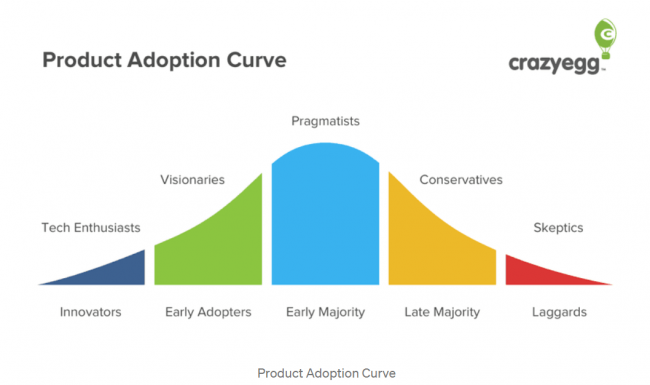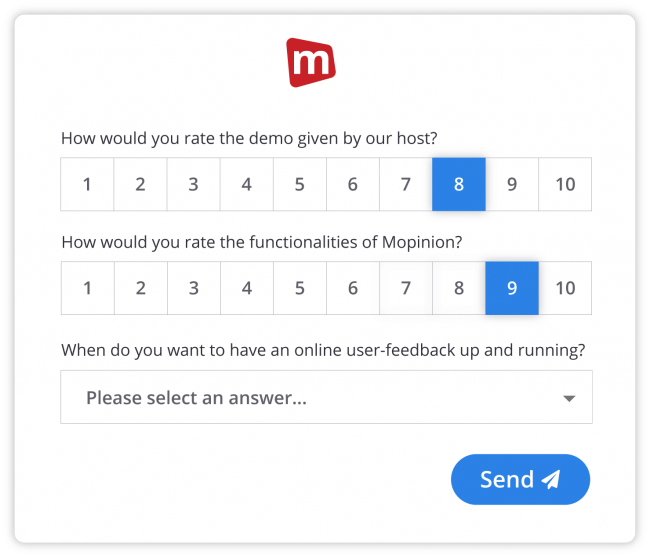We all want to make an impact on our customers and provide them with the best possible digital product(s) on the market – products that ‘stick’. However, creating a ‘sticky’ product – a product that delivers consistent value and is so engaging that users are compelled to use it regularly – is a challenge that many organisations share. So how can you ensure your products (whether that be a new software tool or solution) are effectively being adopted by your users? The answer is user feedback…
In this article, we will identify what product adoption is, who within your organisation should be involved in product adoption, how this is measured, and how you can drive product adoption with the help of user feedback.
What is product adoption?
Product adoption is essentially the process of a user becoming aware of a product, understanding its value and then using it for its intended purpose: to accomplish the user’s goals. In other words, it is a form of acquisition whereby the visitor is converted into a user and truly adopts the product (hence the term product adoption).
However, keep in mind that there are two types of product adoption: soft adoption and hard adoption. Soft adoption occurs when – for example – a visitor signs up for a trial after having a successful demo of your new product. They are satisfied with the content they’ve seen thus far and are willing to invest further in your product. Hard adoption is the next step. This is when – for example – a trial user converts and becomes a paying customer or customer who has had what we call multiple ‘eureka’ moments and is frequently using the product.

Source: Piwik PRO
Note: product adoption is particularly relevant for organisations within the SaaS industry as they often work with a model of retaining users on a monthly and annual basis.

Want to learn how to develop a product your users will love?
Watch our webisode and get tips and tricks on how to create the ultimate user experience in your product.
Who is involved in making product adoption a reality?
Many teams are still unaware of the amount of teamwork and collaboration required to make product adoption a reality…
A good product adoption strategy has many moving parts and involves not just one, but various departments within an organisation, i.e. product, marketing, sales, development, customer support and customer success (Okay, all of them!).
However, three of the most critical departments when it comes to achieving successful product adoption include:
- Customer Success / Customer Experience Department
- Customer Support Department
- Product Department (i.e. product managers, development team)
Why these three? It just so happens that these departments share a common goal. Customer success, support and product departments all want to make sure their customers get the maximum value from their product and achieve the business goals they set out to achieve.
Therefore, ideally these three departments should work together in the process of product adoption. To make this possible, it’s important to have a constant flow of information between customer success, customer support and product managers. Not only will this ensure transparency of information but also boost engagement and cater to a smooth feedback loop.
So how can these teams do this in practice? A good way to start is by measuring product adoption.
How do you measure product adoption?
Interestingly, there are a wide variety of ways to measure product adoption – most of which are used synchronously. For example, some organisations put an emphasis on understanding which channels have the highest adoption rates, how the speed of adoption impacts retention, and how much their users are using their product throughout the product life cycle. Meanwhile others will tune into how ‘sticky’ the product is for their users and which kinds of behaviours they exhibit when engaging with a product (new or old). The common denominator here, however, is data (and how you collect this data).
You won’t be able to improve the adoption rate of your product—or its individual features—without fully understanding these underlying elements of product adoption. To break down the many behaviors that drive adoption and measure them properly, you’ll need to invest in a tech stack that can track user behavior, pipe that data to other systems, and empower your product team to build and test meaningful improvements to your products
Heap
Many organisations advocate leveraging product adoption metrics that are solely quantifiable. From conversion rates and time to value (TTF) to the frequency of purchases and amount of successful onboardings, however, this doesn’t necessarily tell you the full story regarding the user’s experience. And that’s where user feedback comes in.
How can you drive product adoption with user feedback?
User feedback can serve as a great tool for understanding the why behind certain actions in the product adoption process. In other words, it serves up more qualitative insights that are needed to evaluate the experience of the customer and whether they’ve adopted the product. But where do we start?
To kick things off, let’s take a look at what is called the product adoption curve. As you can see in the illustration below, product adoption is broken down into a number of different types of users. For the sake of this article, however, let’s focus on the first two groups: the innovators and early adopters, as these are the users that are often jumping back and forth between products.

Source: CrazyEgg
Your innovators and early adopters will be the users you’ll need to experiment with the most in the beginning as these are the users that will help you get your product off the ground. They will be the first ones to let you know if your product isn’t up to par with their expectations. That is why gathering feedback from these users is key.
Now if we break down the product adoption process into stages, it might look something like this:
- Awareness / Interest
- Demo / Trial
- Onboarding
- Product Adoption
Let’s take a closer look at these stages and how we can gather feedback to further the process along for these users.
1. Awareness / Interest
In the awareness stage, your prospects are familiarising themselves with your product. This is your chance to educate them on your product and prove that your product solves a problem for them in a way that is understandable to them. At this point in time, it’s important to spread the word about your product via advertising, on social media and of course, on your own website, i.e. blog posts, knowledge bases, etc.
In doing so, you’ll want to be certain that the content you’re producing is well received by your prospects. Are you sending the right message to your prospects? Is the content too technical for them? Is it understood what your product offers and how it can be valuable to them? These are the questions user feedback will help you answer, enabling you to create a smooth research process for your prospects.

Here a few examples of content feedback surveys you can use to gather feedback in this stage.
2. Demo / Trial
As we mentioned earlier in this article, the demo and trial stages are critical in determining whether your users will adopt your product. Your content in the awareness stage has educated them enough on your product to the point that they’ve booked a demo to explore more. Congratulations! But now you have to make sure you’re delivering a demo experience that takes them to the next step.
To illustrate how to collect feedback in this stage, let’s use Mopinion as an example. Directly following a product demo with Mopinion, our users receive a feedback survey asking how they experienced the demo:

Example of a feedback survey after a product demo
This feedback will enable you to improve communications within your demo, discover how your product is initially received by your users and hopefully also bring light to which areas of the demo itself need more attention.
Should your demo be a success, your users will then hopefully convert to trial users. This will also be a critical moment to gather feedback as your users are now playing around with the product and testing out functionalities.

Example of a feedback survey during a trial
This feedback can help you understand why they signed up in the first place, or what problems they’re looking to fix with your product, and how you can optimize the trial journey.
3. Onboarding
The next stage is the user onboarding stage.
Note: while this stage is listed as number 3, it is actually applicable to the entire product adoption process (as onboarding already starts in the awareness, demos and trial stages).
The main purpose of user onboarding is to inform and prepare your users for the successful use of your product, however, it also offers an excellent opportunity to learn about the onboarding process as well as your product or service. Which problems are your users facing, which steps in the process are difficult and how can you eliminate these bottlenecks?

Example of an onboarding feedback survey
By asking for feedback in the right moments, i.e. in product tutorials, notifications within the platform, in user manuals, FAQ pages or within email campaigns, you can continuously improve and enhance the onboarding process.
Want to learn more about how to gather feedback in this stage? Be sure to check out User Feedback: The Secret to Successful User Onboarding.
4. Product Adoption
If the trial/onboarding stage is successful and the user is happy with the product, then they will move into the final stage of the product adoption process: fully adopt your product.
In the product adoption stage, teams such as customer success, marketing and sales will be responsible for increasing the total number of users and guiding them through the product adoption process. Meanwhile, product teams will be responsible for keeping these same users engaged and satisfied once they’ve started using the product.

Find out how NCSA builds better products with user feedback
In this story, NCSA explains why nothing can replace capturing feedback from a user actively engaged with your product.
There are two opportunities (and timeframes) to gather feedback on your product and keep the adoption process going strong:
- Surveys on existing products and features. Many organisations start out collecting product feedback to measure the performance of existing products and features.
- New products and services. Alternatively (or simultaneously, really), you can also gather feedback prior to releasing and shortly after the release of a new product.
The important thing to remember here is that feedback should be continuously collected, analysed and shared within the organisation on a regular basis so as to meet the changing expectations of the customer.
There are plenty of product feedback tools – such as Mopinion – on the market that will enable you and your team to effectively gather and analyse this feedback.

Let us guide you on how to collect product feedback
Discover how you can effectively collect product feedback in this complete guide
Taking action as a team
Reflecting on what we’ve mentioned earlier in this article about the different teams involved in this process, now it’s time to hone in on how to put this feedback into action. It is helpful to start thinking about how the different teams can come together to discuss what to do with the feedback received.
For example, when and how will the product team get together to run through the latest feedback submitted by customers? How will the product team and customer success team close the loop with customers and let them know they’re being heard? How will the product managers ensure that the suggestions of their customers are worked into the product roadmap that will be followed by the development team?
Having a data-driven conversation across these teams will not only put you at a competitive advantage, but it will also ensure your customers are being tended to and having their needs met in regards to your product.
Ready to start driving product adoption?
Armed with the knowledge you have now, it’s time to start gathering user feedback. Whether your new product is still in beta or has just been released, there’s no better time to get meaningful insights from your users.
Ready to see Mopinion in action?
Want to learn more about Mopinion’s all-in-1 user feedback platform? Don’t be shy and take our software for a spin! Do you prefer it a bit more personal? Just book a demo. One of our feedback pro’s will guide you through the software and answer any questions you may have.







